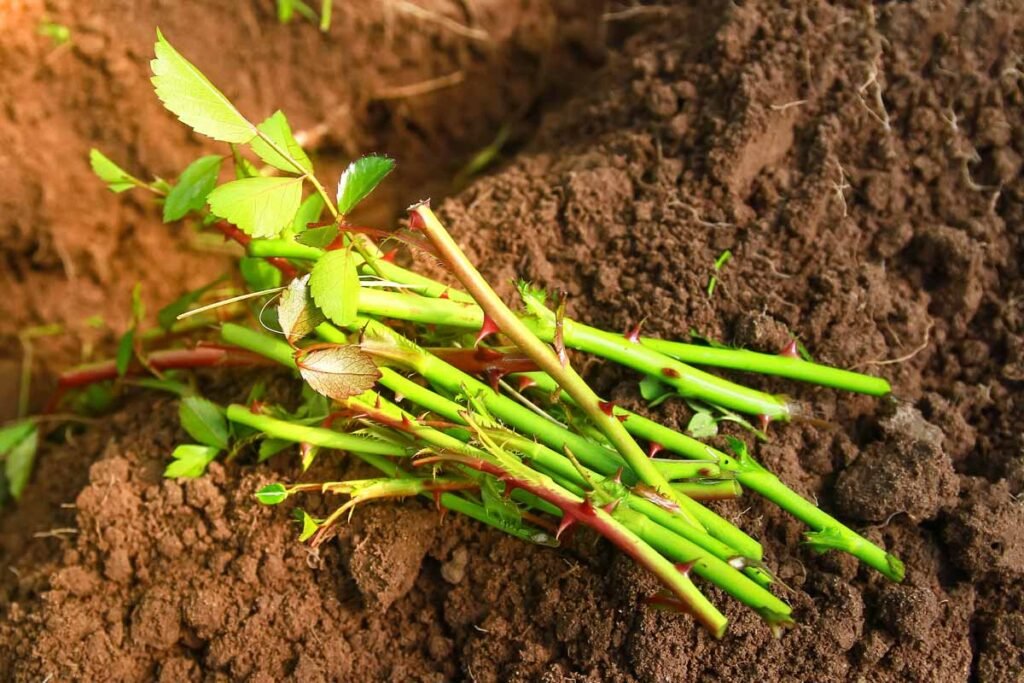Propagating roses from cuttings is a wonderful way to create new rose plants that are genetically identical to the parent plant. Here’s a step-by-step guide on how to do it:
Materials You’ll Need:
- Pruning Shears: Use sharp, clean pruning shears for taking cuttings.
- Roses: Choose a healthy and disease-free rose plant to take cuttings from.
- Rooting Hormone: You’ll need a rooting hormone (powder or gel) to encourage root development.
- Pots or Containers: Prepare small pots or containers for planting the cuttings.
- Potting Mix: Get a well-draining potting mix suitable for rooting cuttings.
- Plastic Bags or Domes: These are used to create a humid environment for the cuttings.
- Rubbing Alcohol: For sterilizing your tools.
- Labels: Use labels to identify the type of rose cuttings.
Steps:
1. Select and Prepare the Rose Cuttings:
- Choose healthy, young stems from the rose plant. The cuttings should be about 6-8 inches long and should include at least one leaf and one or two sets of leaf nodes (the points where leaves and stems meet).
- Use clean, sharp pruning shears to make a clean, slanted cut just below a node at the bottom of each cutting.
2. Remove Leaves and Thorns:
- Remove any leaves or thorns from the lower portion of the cutting, leaving only a few leaves at the top.
3. Apply Rooting Hormone:
- Dip the cut end of each cutting into a rooting hormone, making sure to coat the bottom inch or so of the stem.
4. Plant the Cuttings:
- Plant the cuttings in pots filled with a well-draining potting mix. You can plant multiple cuttings in the same container, but make sure they’re not overcrowded.
5. Water Thoroughly:
- Water the cuttings thoroughly after planting to settle the soil and ensure good contact between the cutting and the soil.
6. Create a Humid Environment:
- Place a plastic bag or a plastic dome over the cuttings to create a humid environment. This helps retain moisture and encourages root development.
- Ensure that the bag or dome is not touching the leaves of the cuttings.
7. Provide Indirect Light:
- Place the containers with cuttings in a location with bright, indirect light. Avoid direct sunlight, as it can overheat the cuttings.
8. Maintain Moisture:
- Regularly check the soil to ensure it stays evenly moist but not waterlogged. Mist the cuttings with water if the soil begins to dry out.
9. Root Development:
- It may take several weeks to a few months for the cuttings to develop roots. You can check for root development by gently tugging on the cutting; resistance indicates the presence of roots.
10. Transplanting:
- Once the cuttings have well-established roots, usually when they are around 2-3 inches long, transplant them into individual pots or your garden. Plant them in a sunny location with well-draining soil.
11. Monitor and Care:
- Continue to care for your newly propagated roses, watering as needed and protecting them from harsh conditions.
Propagation from cuttings is a rewarding way to grow new rose plants that carry the qualities of your favorite varieties. While it requires patience, the joy of seeing healthy, new rose plants flourish in your garden is well worth the effort.

